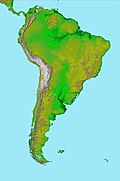Coquimbo Formation
Appearance
| Coquimbo Formation | |
|---|---|
| Stratigraphic range: Miocene–Pliocene | |
| Type | Geological formation |
| Lithology | |
| Primary | Conglomerate, sandstone, siltstone, shale and coquina |
| Other | Clay lences, terra rossa |
| Location | |
| Region | Coquimbo Region |
| Country | Chile |
| Type section | |
| Named for | Coquimbo |
Coquimbo Formation (Template:Lang-es) is a Miocene and Pliocene sedimentary formation located in Coquimbo Region in Norte Chico, Chile. In the area of Tongoy the Coquimbo Formation was deposited in an ancient bay that was formed in a graben or half-graben, with a normal fault dipping east. Sea level changes during the Holocene have caused erosion to cut several marine terraces into the formation.[1]
See also
References
- ^ Le Roux, J.P.; Olivares, Danisa M.; Nielsen, Sven N.; Smith, Norman D.; Middleton, Heather; Fenner, Juliane; Ishman, Scott E. (2006). "Bay sedimentation as controlled by regional crustal behaviour, local tectonics and eustatic sea-level changes: Coquimbo Formation (Miocene–Pliocene), Bay of Tongoy, central Chile" (PDF). Sedimentary Geology. 184 (1–2): 133–153. Retrieved 11 April 2016.

